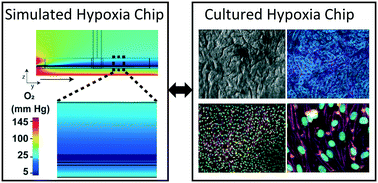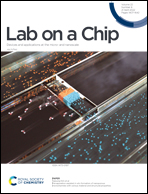Establishment of physiologically relevant oxygen gradients in microfluidic organ chips†
Abstract
In vitro models of human organs must accurately reconstitute oxygen concentrations and gradients that are observed in vivo to mimic gene expression, metabolism, and host–microbiome interactions. Here we describe a simple strategy to achieve physiologically relevant oxygen tension in a two-channel human small intestine-on-a-chip (Intestine Chip) lined with primary human duodenal epithelium and intestinal microvascular endothelium in parallel channels separated by a porous membrane while both channels are perfused with oxygenated medium. This strategy was developed using computer simulations that predicted lowering the oxygen permeability of poly-dimethylsiloxane (PDMS) chips in specified locations using a gas impermeable film will allow the cells to naturally decrease the oxygen concentration through aerobic respiration and reach steady-state oxygen levels <36 mm Hg (<5%) within the epithelial lumen. The approach was experimentally confirmed using chips with embedded oxygen sensors that maintained this stable oxygen gradient. Furthermore, Intestine Chips cultured with this approach supported formation of a villus epithelium interfaced with a continuous endothelium and maintained intestinal barrier integrity for 72 h. This strategy recapitulates in vivo functionality in an efficient, inexpensive, and scalable format that improves the robustness and translatability of Organ Chip technology for studies on microbiome as well as oxygen sensitivity.



 Please wait while we load your content...
Please wait while we load your content...